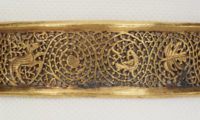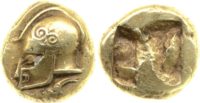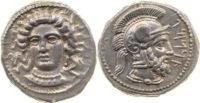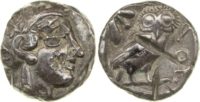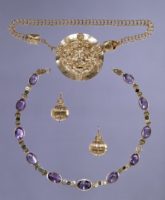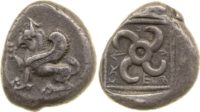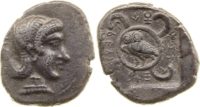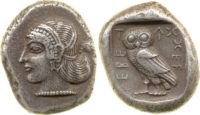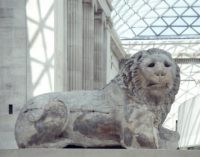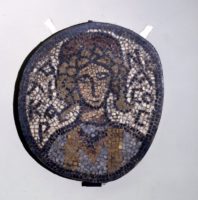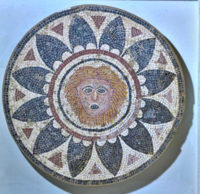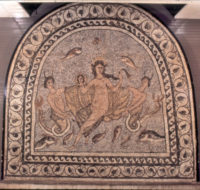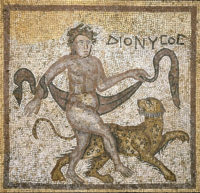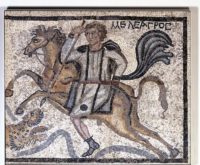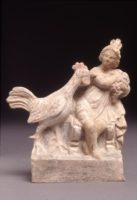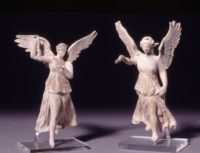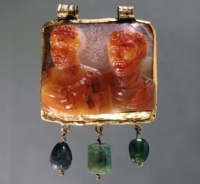Bracelet, Period: Late Roman circa: 379 – 395 A.D. Medium: Gold. Dimensions: 1.4 × 6.3 cm (9/16 × 2 1/2 in.) Museum Description: “A simple gold band with plain flanged edges forms this openwork bracelet. A vegetal scroll weaves across the surface of the band, into which hunting scenes are inserted. On one side a hound chases a stag, while on the other a hound pursues a hare. ”
The J. Paul Getty Museum at the Getty Center in Los Angeles houses European paintings, drawings, sculpture, illuminated manuscripts, decorative arts, and photography from its beginnings to the present, gathered internationally.
Bracelet, Period: Late Roman circa: about 379 – 395 A.D., Materials: Gold, emeralds, sapphires, and glass, Dimensions: 2.8 × 5.8 cm (1 1/8 × 2 1/4 in.). The J. Paul Getty Museum at the Getty Center in Los Angeles houses European paintings, drawings, sculpture, illuminated manuscripts, decorative arts, and photography from its beginnings to the present, gathered internationally.
Electrum Greek Coin. Period: 6th c. B.C. circa: 521BC-478BC; Minted in: Phocaea (Asia, Modern Turkey,Marmara Region, Phocaea) Weight: 2.547 grammes. British Museum is closed 24, 25 and 26 December and 1 January, but is open every other day of the year. Fast facts about the British Museum: Founded: 1753, Collection size: 8 million objects, Oldest object in the collection: Stone chopping tool (nearly 2 million years old).
Silver coin, Period: 4 th. century B.C. 378BC-372BC (circa), Ruler: Datames, Minted in: Tarsus (Modern Turkey, Mersin Province) Museum Description: “Silver coin.(obverse) Baal seated r. (reverse) An standing r. facing Tarkumuwa.” British Museum is closed 24, 25 and 26 December and 1 January, but is open every other day of the year. Fast facts about the British Museum: Founded: 1753, Collection size: 8 million objects, Oldest object in the collection: Stone chopping tool (nearly 2 million years old).
Silver Coin. Period: 4th century B.C. 378BC-372BC (circa). Minted in: Tarsus (Modern Turkey, Mediterranean Region, Mersin (province),Anatolia ) Ruler: Datames. Museum Description: “(obverse) Female head facing. (reverse) Bearded head with crested helmet l.” British Museum is closed 24, 25 and 26 December and 1 January, but is open every other day of the year. Fast facts about the British Museum: Founded: 1753, Collection size: 8 million objects, Oldest object in the collection: Stone chopping tool (nearly 2 million years old).
Silver Coin, Period: 4 th century B.C. 330BC (circa); Museum Description: “Silver coin.(obverse) Head of nymph Sinope waring earring. (reverse) Eagle above dolphin.” Minted in: Sinope (Modern Turkey, Black Sea Region Sinop Province) British Museum is closed 24, 25 and 26 December and 1 January, but is open every other day of the year. Fast facts about the British Museum: Founded: 1753, Collection size: 8 million objects, Oldest object in the collection: Stone chopping tool (nearly 2 million years old).
Museum Description: “Silver coin.(obverse) Head of Athena right, wearing earring and crested helmet decorated with olive-leaves. (reverse) Owl within incuse square, right; to left, olive-spray and crescent.” Period: 5 th century B.C., Minted in: Athens, Greece; Excavated/Findspot: Cilicia (Anatolia, Modern Turkey). British Museum is closed 24, 25 and 26 December and 1 January, but is open every other day of the year. Fast facts about the British Museum: Founded: 1753, Collection size: 8 million objects, Oldest object in the collection: Stone chopping tool (nearly 2 million years old).
Museum Description: “Pair of gold earrings in the shape of a half globe with a small disc above, decorated in relief with a female dramatic mask.” Period: Roman, circa: 2nd century A.D. Made in/Findspot: Miletopolis, Modern Turkey, Aegean Region, Anatolia. Dimensions: Height: 3.81 centimetres. British Museum is closed 24, 25 and 26 December and 1 January, but is open every other day of the year. Fast facts about the British Museum: Founded: 1753, Collection size: 8 million objects, Oldest object in the collection: Stone chopping tool (nearly 2 million years old).
Silver Coin, Period: 5th. century B.C. 480BC-460BC (circa). Minted in Lycia, Anatolia, Modern Turkey. Ruler: Taththivaibi Museum Description: “(obverse) Griffin, curved wing, seated left; right forepaw raised. (reverse) Tetraskeles left; in dotted incuse square.” British Museum is closed 24, 25 and 26 December and 1 January, but is open every other day of the year. Fast facts about the British Museum: Founded: 1753, Collection size: 8 million objects, Oldest object in the collection: Stone chopping tool (nearly 2 million years old).
Silver Coin, Period: 5th c. 410 B.C. (circa) Minted in Lycia, Anatolia, Turkey. Ruler: Khariga, Materials: silver. Museum Description: Head of Aphrodite left, rows of formal curls on fore-head, hair fastened by band passing three times round it, and caught up behind; truncation on neck dotted; symbol, resembling T on neck.
(reverse) Tetraskeles right, members of which divide the legend; in inner ring, owl standing left, head to front; symbol at beginning of inscription: the whole. British Museum is closed 24, 25 and 26 December and 1 January, but is open every other day of the year. Fast facts about the British Museum: Founded: 1753, Collection size: 8 million objects, Oldest object in the collection: Stone chopping tool (nearly 2 million years old).
Silver Coin, Period: 5thc. B.C., Ancient Greek circa: 480 B.C-460 B.C, Ruler: Taththivaibi, Minted in: Lycia (Modern Turkey, Anatolia) Museum Description: Head of Aphrodite left, rows of formal curls on fore-head, hair fastened by band passing three times round it, and caught up behind; truncation on neck dotted; symbol, resembling T on neck. (reverse) Tetraskeles right, members of which divide the legend; in inner ring, owl standing left, head to front; symbol at beginning of inscription: the whole. British Museum is closed 24, 25 and 26 December and 1 January, but is open every other day of the year. Fast facts about the British Museum: Founded: 1753, Collection size: 8 million objects, Oldest object in the collection: Stone chopping tool (nearly 2 million years old).
[xyz-ihs snippet="British-Museum"]The Lion of Knidos, Museum Description: Colossal marble statue of a recumbent lion; carved with inlaid eyes originally probably of glass, but now missing. Period: Hellenistic, circa: 2nd century BC. Excavated/Findspot: Knidos, Lion Tomb (Turkey, Aegean Region, Caria, Knidos Ancient City, Anatolia). Materials: marble, glass (eyes). Technique: inlaid (eyes) carved. Dimensions: Length: 2.89 metres Height: 1.82 metres. Location: Not on display (Great Court) Acquisition date: 1859, Discovered by Richard Pullan during Charles Newton’s excavations in 1858; removed by Robert Murdoch Smith; brought back on HMS Supply. British Museum is closed 24, 25 and 26 December and 1 January, but is open every other day of the year. Fast facts about the British Museum: Founded: 1753, Collection size: 8 million objects, Oldest object in the collection: Stone chopping tool (nearly 2 million years old).
[xyz-ihs snippet="British-Museum"]Circular mosaic. Personification of the city of Halicarnassus. Period: Late Roman; circa: 4th c.; Excavated/Place: Halicarnassus, Modern Turkey, Aegean Region, Anatolia. Materials: stone. Dimensions: Height: 54.5 centimetres Width: 49.5 centimetres. British Museum is closed 24, 25 and 26 December and 1 January, but is open every other day of the year. Fast facts about the British Museum: Founded: 1753, Collection size: 8 million objects, Oldest object in the collection: Stone chopping tool (nearly 2 million years old).
Roman Mosaic, Period: Late Roman; circa: 4th c.; Excavated/Place: Caria, Bodrum, Hadji Captan’s Field (Halicarnassus), Anatolia. Materials: stone. Dimensions: Diameter: 105.41 centimetres. Museum Description: Stone mosaic; medallion with mask of Phobos in the centre of rosette with 12 petals; triangles between rosette petals; the mask is red-brown and ochre; rosette petals are black and the triangles are red-brown. British Museum is closed 24, 25 and 26 December and 1 January, but is open every other day of the year. Fast facts about the British Museum: Founded: 1753, Collection size: 8 million objects, Oldest object in the collection: Stone chopping tool (nearly 2 million years old).
Mosaic of Venus and Tritons, Period: Late Roman; circa: 4th c.; Materials: stone. Dimensions: Height: 1.96 metres Width: 2.11 metres (at base) Excavated/Place: Caria, Bodrum, Hadji Captan’s Field (Halicarnassus). Excavated by: Sir Charles Thomas Newton, 1857. Museum Description: Venus is seated on a twisted shell, which is seen to the right; In her right hand she holds a circular mirror which reflects her full face; in her left hand she holds a long tress of hair; behind her is a veil held by a Triton on either side; the Tritons have curling forked tails and a pair of claws on their heads; below are two dolphins, one crab, and three. British Museum is closed 24, 25 and 26 December and 1 January, but is open every other day of the year. Fast facts about the British Museum: Founded: 1753, Collection size: 8 million objects, Oldest object in the collection: Stone chopping tool (nearly 2 million years old).
Mosaic Pavement; Period: Late Roman; circa: 4th c.; Excavated/Place: Halicarnassus, Modern Turkey, Aegean Region, Anatolia. Materials: stone. Dimensions: Height: 1.4 metres Width: 1.36 metres. Museum Description: Panel from a mosaic pavement, Dionysos dances to the right, with the panther running behind and looking up at him. Dionysos wears a grey-green wreath, and carries a strip of red drapery edged with black. The name of Dionysos is inscribed in Greek.
British Museum is closed 24, 25 and 26 December and 1 January, but is open every other day of the year. Fast facts about the British Museum: Founded: 1753, Collection size: 8 million objects, Oldest object in the collection: Stone chopping tool (nearly 2 million years old).
Mosaic Pavement; Period: Late Roman; circa: 4th c.; Excavated/Place: Halicarnassus, Modern Turkey, Aegean Region, Anatolia. Materials: stone. Dimensions: Height: 1.4 metres Length: 1.67 metres. Museum Description: Part of a panel from a mosaic pavement: Meleager, on horseback, spears a leopard. The panel is inscribed in Greek with the hero’s name.
British Museum is closed 24, 25 and 26 December and 1 January, but is open every other day of the year. Fast facts about the British Museum: Founded: 1753, Collection size: 8 million objects, Oldest object in the collection: Stone chopping tool (nearly 2 million years old).
Terracotta figure of a boy with a cock, Period: Hellenistic, 1th c. BC. (circa) Material: Terracotta. Boy sprawling back across a low bench with finely modelled legs, leaning to the viewer’s right, both hands holding a big bunch of grapes out of the way of a very large predatory cock approaching from the left. Excavated: Myrina Ancient City, Anatolia. (Modern Turkey, Aliaga, Izmir) Acquisition date: 1891. British Museum is closed 24, 25 and 26 December and 1 January, but is open every other day of the year. Fast facts about the British Museum: Founded: 1753, Collection size: 8 million objects, Oldest object in the collection: Stone chopping tool (nearly 2 million years old).
Terracotta Figure of Winged Nike Flying, wings raised, Period: Hellenistic 1stc(late) BC-1stc(early) (circa) Acquisition Date: 1893. Her left leg outstretched (perhaps coming down to land), her right hand raised and holding a small wreath, her left hand pulling at the drapery on her left thigh, wearing peplos belted high up under the breasts leaving her left bare, her left leg emerging from the garment at thigh level, wavy centrally parted hair drawn back into. Made in: Myrina, Anatolia (Modern Turkey) British Museum is closed 24, 25 and 26 December and 1 January, but is open every other day of the year.
Busts of Two Emperors, Period: Roman, Circa: Late 3rd-early 4th century, Material: Chalcedony on gold. The museum is open to the public Tuesday through Sunday, 11:30 a.m.–5:30 p.m., except for federal holidays.


